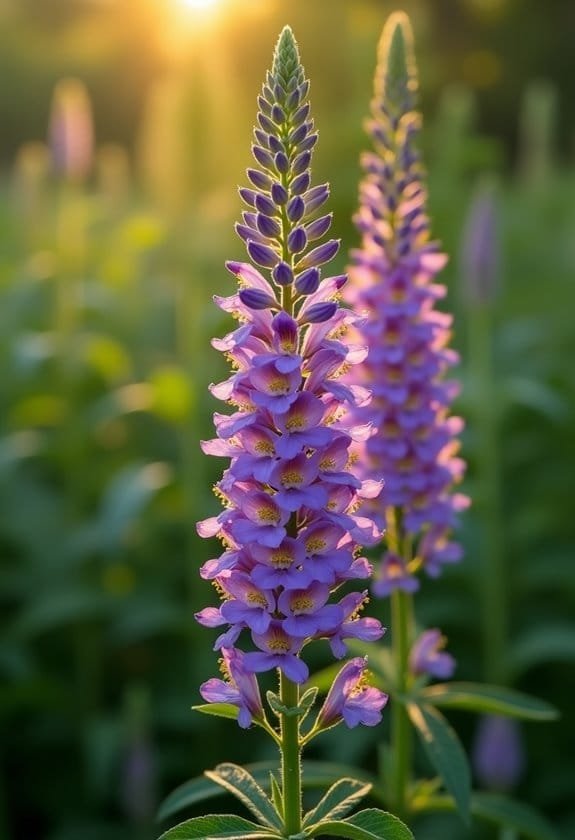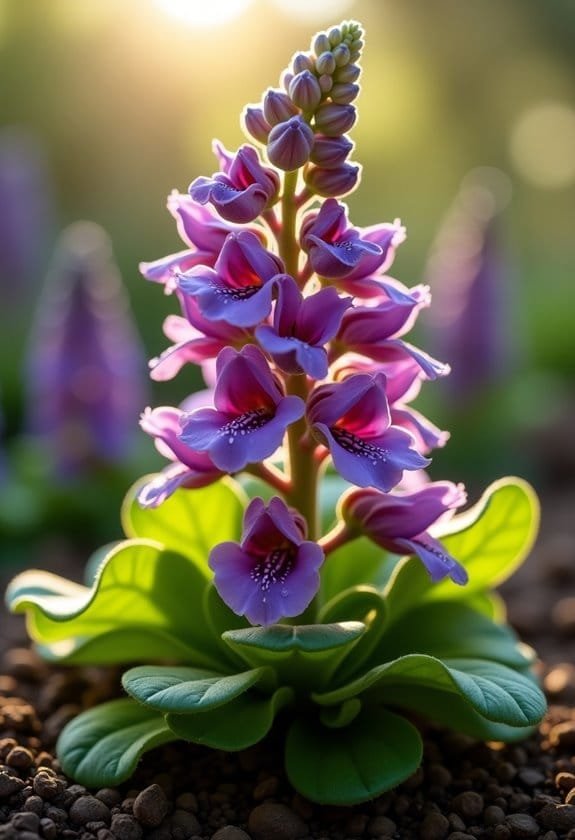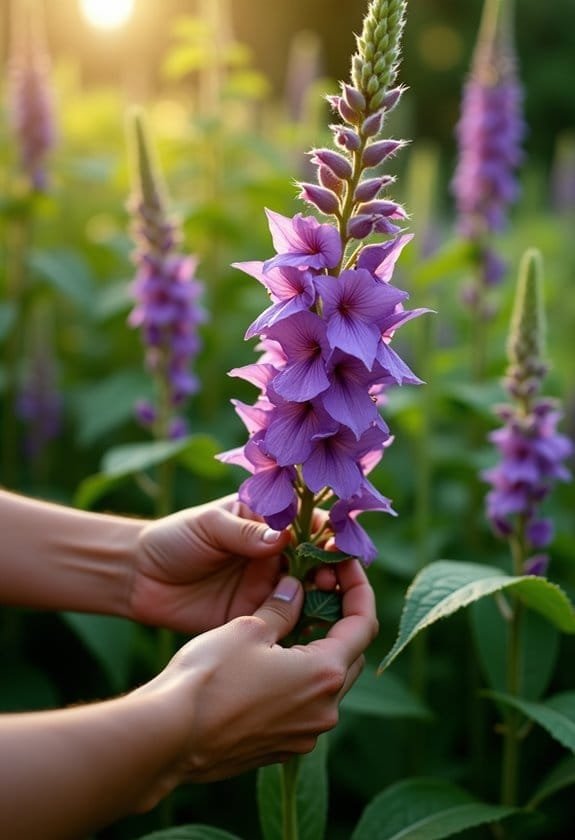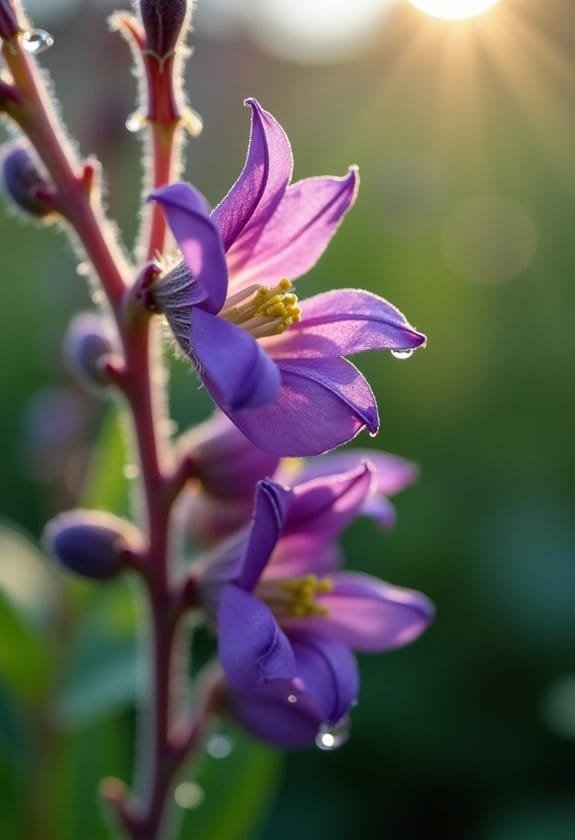Verbascum phoeniceum, or Purple Mullein, stands out in gardens with its striking deep violet-purple flowers that bloom on slender spikes. Reaching heights of 24-36 inches, this perennial thrives in USDA zones 6 to 10, favoring full sun and well-drained, alkaline soil. This plant attracts essential pollinators, such as bees and hummingbirds, enhancing garden biodiversity. With minimal care required, including regular deadheading and pest monitoring, Purple Mullein is perfect for drought-tolerant landscapes. Its robust nature complements gravel and rock gardens beautifully, inviting further exploration of its ecological and aesthetic benefits for avid gardeners and nature enthusiasts alike.
Main Points
- Verbascum phoeniceum, commonly known as Purple Mullein, features striking deep violet-purple blooms and grows 24-36 inches tall.
- This perennial plant thrives in full sun and well-drained, alkaline soils, requiring minimal watering when established.
- Blooming occurs from late spring to early summer, attracting pollinators like bees, hoverflies, and hummingbirds.
- Purple Mullein is ideal for gravel, cottage, and rock gardens, enhancing visual interest and supporting biodiversity.
- Regular maintenance includes deadheading spent flowers and monitoring for pests to ensure healthy growth.
Introduction

Verbascum phoeniceum, often referred to as Purple Mullein, captivates gardeners with its striking 24-36 inch stature and airy spikes adorned in deep violet-purple blooms.
This evergreen perennial not only thrives in challenging conditions, such as poor alkaline soils, but also plays a crucial role in enhancing garden biodiversity by attracting hummingbirds and various pollinators.
Common Name
Known for its striking appearance, Purple Mullein, or Violetta Mullein, enchants gardeners with its dark violet-purple flowers. This enchanting plant produces airy spikes of rich blooms that feature a flat face, distinct darker center, and radiant golden stamens.
Grown primarily in full sun, Purple Mullein thrives in well-drained soils, making it an excellent choice for gravel or cottage gardens.
Reaching heights of 24 to 36 inches (60 to 90 cm) and spreading up to 36 inches (90 cm) wide, its tall stature provides a vertical accent that enhances garden aesthetics.
Purple Mullein's drought-tolerant nature allows it to endure dry periods, appealing to those looking for low-maintenance flora.
In addition to its ornamental value, this plant plays a significant role in promoting biodiversity, as it attracts hummingbirds and various pollinators, enriching the ecological balance within any garden.
Consequently, with its striking flowers and environmental benefits, Violetta Mullein becomes not just a beautiful addition, but an essential contributor to the vibrancy and sustainability of garden ecosystems.
Scientific Name
Purple Mullein, scientifically classified as Verbascum phoeniceum, is a member of the Scrophulariaceae family. This biennial or short-lived perennial typically reaches heights of 24 to 36 inches (60 to 90 cm) and showcases striking dark violet-purple flowers that bloom along slender spikes.
Native to southern Europe, northern Africa, and central Asia, Verbascum phoeniceum thrives in dry, well-drained soils, making it a robust candidate for various landscapes.
Interestingly, this species exhibits self-incompatibility, meaning it requires cross-pollination with other plants for successful seed set. This characteristic enhances its biodiversity, allowing for a greater genetic pool and resilience.
The scientific name, Verbascum phoeniceum, reflects its distinctiveness within the broader Mullein group, accentuating its ecological role and potential as a source of biomass.
As a member of the Scrophulariaceae, Purple Mullein joins an extensive family of flowering plants, contributing not just to ornamental aesthetics but also to ecosystem dynamics.
The unique features of Verbascum phoeniceum set it apart, establishing it as a valuable species within its native habitats and cultivated areas alike.
Overview
A stunning addition to gardens, Purple Mullein (Verbascum phoeniceum) captivates with its tall spikes adorned with deep violet-purple flowers.
This evergreen perennial flourishes in late spring to summer, reaching heights of 24 to 36 inches (60 to 90 cm) and spanning up to 36 inches (90 cm) in width. As a versatile plant, it aligns beautifully in smaller gardens, offering vertical accents to borders and beds.
Known as Verbascum phoeniceum Violetta, this plant thrives in full sun exposure and prefers well-drained soils, even exhibiting drought tolerance, which keeps it low-maintenance. Its deer-resistant nature further enhances its appeal for gardeners.
Purple Mullein's ecological benefits extend beyond aesthetics; it serves as an essential resource for various pollinators, including hummingbirds and butterflies. Such interactions boost biodiversity, making it a favored choice for pollinator-friendly gardens.
Hardy in USDA zones 6-10, Verbascum phoeniceum adapts well to moderate to warm climates, ensuring gardeners can enjoy its striking beauty and ecological contributions across diverse landscapes.
Indeed, this exceptional plant embodies a harmonious blend of functionality, beauty, and sustainability.
Key Features
Verbascum phoeniceum stands out with its impressive growth size, typically reaching heights of 24 to 36 inches, while spreading about 36 inches wide.
The plant's appearance is striking, featuring airy spikes adorned with rich violet-purple flowers that emerge from late spring through summer, adding a splash of color to any garden setting.
This perennial's unique combination of stature and vibrant blossoms not only enhances vertical interest but also invites a variety of pollinators, enriching the ecological landscape.
Growth Size
Known for its striking visual appeal, the Purple Mullein boasts a growth size that typically reaches 24-36 inches in height and can spread up to 36 inches wide. This hardy perennial plant exhibits a distinctive rosette growth habit, with shiny, dark green leaves forming a lush base that supports the airy flowering spikes.
Unlike many larger mulleins, Purple Mullein remains relatively compact, making it an excellent choice for smaller gardens or as a vertical accent in borders and beds. It thrives in USDA zones 6-10, showcasing adaptability to a range of climates and soil conditions.
This resilience allows its growth size and bloom characteristics to vary, enabling gardeners to enjoy robust, vibrant floral displays that can transform any landscape. As the plant matures, its unique proportions offer visual interest without overwhelming the surrounding flora, providing a harmonious balance in garden design.
Additionally, the flowering period occurring from late spring to summer further enhances its value in a garden setting. Consequently, the Purple Mullein's impressive growth size, alongside its hardiness, positions it as a favored option for both novice and seasoned gardeners alike.
Appearance
What makes the Purple Mullein stand out in any garden are its breathtaking flowers and unique foliage. The plant boasts airy spikes adorned with rich violet-purple flowers, each displaying a mesmerizing flat face complemented by darker centers. This striking contrast not only enhances its beauty but also attracts essential pollinators like hummingbirds and butterflies.
Typically reaching heights between 24 to 36 inches (60 to 90 cm) and spreading about 36 inches (90 cm) wide, it fits perfectly in compact garden spaces without overwhelming the surrounding flora.
The foliage of Purple Mullein consists of ground-hugging dark green leaves that feature a subtle purple tint, adding to its year-round visual interest. This combination of colors creates an alluring backdrop for the vibrant blooms that emerge in late spring to summer.
The plant's morphology includes a rosette growth form, which allows the lower blooms to grace the garden first, cascading into a stunning display as summer progresses. Such a distinctive appearance not only makes Purple Mullein an aesthetically pleasing choice for any landscape but also contributes considerably to the ecological balance by supporting local pollinators.
Flowering Season
During late spring to early summer, Purple Mullein bursts into bloom, charming onlookers with its striking violet-purple flowers. This perennial plant showcases its colorful display for approximately two weeks, fascinating both gardeners and pollinators alike.
Arranged along slender spikes that can tower between 24 to 36 inches, these flowers create a dramatic vertical accent, drawing attention in garden spaces. Each flower features a flat face adorned with a deeper-hued center and golden stamens, which beckon hummingbirds and butterflies, crucial allies in its pollination process.
While the flowering season generally remains consistent, some variance might occur based on local climate conditions, subtly influencing the plant's height and coloration. This adaptability highlights Purple Mullein's resilience in the face of environmental factors.
To enhance the blooming period, a gardener can practice deadheading, removing spent flower spikes to stimulate new growth and potentially prolong the flowering season. Consequently, the blooming period not only delights the senses but also serves as an essential resource for local ecosystems, ensuring a continued presence of vibrant life and color in the garden throughout its seasonal display.
Growing Requirements

Verbascum phoeniceum flourishes under the bright embrace of full sun, essential for robust growth and vibrant flowering.
Preferring well-drained, alkaline soils—often considered poor to medium in nutrient content—this resilient species demonstrates notable drought tolerance once it's well-established in its environment.
Hardy across USDA zones 6 to 10, this plant's adaptable nature allows it to thrive in a variety of moderate to warm climates, offering gardeners versatility in their cultivation efforts.
Light
Purple Mullein thrives best in full sun, requiring direct sunlight for ideal growth and vibrant flowering. This remarkable species, Verbascum phoeniceum, flourishes with full sun exposure, making it essential for gardeners to position it accordingly in their landscapes. Best possible growth occurs when the plant receives at least six hours of sunlight each day, fostering robust development and prolific blooms that capture attention.
The relationship between sunlight and plant health is profound; as Purple Mullein basks in warm rays, it exhibits striking height variations and extending blooming periods. A well-lit environment promotes the plant's adaptability to average to moist, well-drained soils, enabling it to flourish in diverse conditions.
Even more impressive, established plants develop drought tolerance, successfully withstanding periods of infrequent watering once mature. This resilience allows them to thrive, making them suitable for gardens with varying moisture levels.
Ultimately, the preference for full sun transforms the Purple Mullein into an outstanding addition to pollinator gardens. By creating sunlit environments, gardeners not only enjoy the aesthetic reward of vibrant flowers but also contribute positively to local ecosystems, attracting essential pollinators.
Hence, gardeners must strictly adhere to its light requirements for best possible results.
Soil
For successful growth, a well-drained soil structure is crucial for the thriving of Purple Mullein. This plant flourishes in poor to medium-quality soils that possess alkaline conditions, which greatly enhance its development. Remarkably, it demonstrates exceptional drought tolerance, making it particularly suitable for gardens where regular watering may not be feasible, especially once established.
While cultivating this striking perennial, gardeners should verify that the soil isn't soggy; overly moist environments lead to detrimental conditions that may cause root rot, jeopardizing the plant's health.
Purple Mullein thrives best when planted in full sun, as sufficient sunlight contributes to vibrant blooms and overall vigor.
Interestingly, this species exhibits a tendency to self-seed, enabling natural propagation across various soil types, thereby demonstrating its adaptable nature.
For best results, mixing in coarse materials like sand or gravel can further improve drainage, creating the ideal environment for growth.
Ultimately, understanding and providing for these soil requirements not only supports the Purple Mullein's flourishing but also enhances the biodiversity and beauty of the surrounding landscape.
Water
Effective watering is essential for the healthy growth of Purple Mullein, especially during its early stages. While this species, Verbascum phoeniceum, is highly drought tolerant once established, young plants require regular watering to develop strong root systems and thrive. During dry spells, ensuring adequate moisture helps prevent them from wilting and promotes robust growth.
Purple Mullein prefers well-drained soils, and its adaptability to average to poor conditions makes it a suitable choice for low-water gardens. However, gardeners must exercise caution; overly moist environments can lead to root rot, which severely hampers the plant's health.
During the blooming period, maintaining consistent moisture proves advantageous, as it enhances flower production and vibrancy. Yet, it's important not to overwater, as excess water can be detrimental.
Once established, these plants typically require minimal watering, as they can rely on their innate drought-resistant traits and often self-seed in favorable conditions. Implementing a balanced watering regime not only supports the plant's growth but also enriches the garden environment, contributing to a flourishing ecosystem that thrives on diversity and resilience.
Temperature
Growing conditions for Verbascum phoeniceum hinge on temperature and sunlight. Thriving in USDA hardiness zones 6-10, this plant flourishes in moderate to warm climates, embracing full sun exposure with a need for at least six hours of direct sunlight daily. This requirement guarantees the ideal growth and vibrant blooming characteristic of Purple Mullein.
Once established, the plant exhibits impressive drought tolerance, enabling it to withstand dry spells without compromising liveliness. Such resilience allows it to thrive in various environments, especially those marked by well-drained soils, which are crucial for preventing root rot in cooler temperatures.
In less than ideal conditions, such as poor or medium soils, Purple Mullein still manages to adapt, although its growth may not reach full potential.
Self-seeding is another key feature that facilitates natural proliferation, as the plant effectively spreads in areas with favorable temperatures and moisture levels. Consequently, gardeners should consider these temperature requirements, as well as soil quality and sunlight availability, when cultivating Verbascum phoeniceum to guarantee their success.
Pollinator Criteria
In the rich tapestry of its ecosystem, Verbascum phoeniceum serves as a beacon for a multitude of pollinators, including bees, hoverflies, and enchanting hummingbirds.
The plant's vibrant dark violet-purple flowers, adorned with golden stamens, not only draw these essential pollinators through their fragrant allure, but also facilitate their role in cross-pollination, a critical method for the plant's reproductive success.
Attracted Pollinators
Purple Mullein, or Verbascum phoeniceum, attracts a diverse range of pollinators, making it a valuable addition to any garden. Its vibrant, richly hued violet flowers, adorned with striking golden stamens, serve as a beacon for pollinators in search of nectar. This visual allure, combined with a mild fragrance, draws in butterflies, hummingbirds, bees, and hoverflies, all of which play essential roles in maintaining ecological balance.
Blooming from late spring to summer, Purple Mullein guarantees a consistent food source during a time when pollinators are particularly active. This abundant nectar not only sustains pollinators but also promotes biodiversity, creating a more dynamic ecosystem.
Moreover, the plant's self-seeding nature allows it to establish a continuous presence in gardens, benefiting various species over time.
Pollination Method
Frequently relying on cross-pollination, Verbascum phoeniceum requires the active participation of various pollinators due to its self-incompatibility. The plant's striking dark violet-purple blooms, complete with golden stamens, send out a fragrant scent that beckons crucial visitors such as bees, hoverflies, and moths. These visual and olfactory cues greatly increase the likelihood of successful pollination.
Pollination primarily occurs during the flowering period from late spring to summer, precisely when the flower stalks are fully developed and accessible for insect activity. Each flower facilitates cross-pollination by employing a strategy known as floral symmetry, which guarantees pollinators can efficiently gather and transfer pollen. This intricate relationship not only aids in seed set but also promotes genetic diversity.
Moreover, the plant's ability to self-seed complements its need for cross-pollination, enhancing its effectiveness in garden settings and guaranteeing robust populations.
The fragrant scent, a pleasant draw for pollinators, acts like nature's invitation, underscoring the interconnectedness of plants and their animal partners. This remarkable synergy between Verbascum phoeniceum and its pollinators illustrates a delicate balance essential for sustaining the ecosystem.
Care & Maintenance

When it comes to the care and maintenance of Verbascum phoeniceum, proper planting and ongoing care play vital roles in its success.
This resilient perennial thrives in poor to medium soils, requiring minimal fertilization, yet benefits greatly from regular deadheading of spent flower spikes to promote new growth and extended blooming periods.
Additionally, establishing harmonious companion plants can enhance its aesthetic appeal while fostering a vibrant ecosystem that supports pollinators and deters pests.
Planting Tips
To guarantee successful growth, gardeners should plant Verbascum phoeniceum in well-drained, alkaline soil that receives full sun. This vibrant perennial thrives in USDA hardiness zones 6-10, exhibiting remarkable resilience against drought once established.
When considering planting tips, it's vital to prepare the soil adequately, ensuring it drains well to prevent root rot—a frequent challenge for many gardeners. During dry spells, regular watering is advisable, yet overwatering must be avoided; the plant favors poor to medium soil conditions, highlighting its adaptability.
Gardeners can enhance the plant's visual appeal by deadheading spent flower spikes, stimulating new growth and prolonging the blooming period. As diligent caretakers, they should monitor for common pests like caterpillars and figwort weevil, as well as symptoms of powdery mildew, to maintain the plant's vigor.
Propagation methods include division in spring or root cuttings in winter, allowing gardeners to expand their collection without strain. When transplanting seedlings, careful handling is essential to prevent damage, ensuring a smooth progression into their new surroundings.
Ongoing Care
Ongoing care for Verbascum phoeniceum secures the plant remains vibrant and healthy. To maintain its lush appearance, gardeners should regularly remove spent flower spikes, prompting vigorous new growth and deterring leggy behavior.
While these plants exhibit remarkable drought tolerance once established, they still require careful watering during prolonged dry spells to thrive effectively.
Monitoring for pests like caterpillars and figwort weevil is essential, as timely intervention can prevent severe infestations that compromise the plant's vigor. Effective pest management guarantees the plant continues to flourish throughout its growing season, maintaining its striking aesthetic appeal.
Pruning also plays a significant role in supporting healthy growth; flopping foliage should be trimmed, especially when the plant finds itself thriving in nutrient-rich soil conditions.
By keeping foliage manageable, gardeners can preserve both the plant's form and overall health. This combination of strategic pruning, vigilant pest monitoring, and meticulous watering assures that Verbascum phoeniceum not only withstands environmental challenges but also captivates admirers with its vibrant presence, becoming an enduring staple in the garden landscape.
With these practices, one can appreciate the full splendor of this stunning perennial throughout the seasons.
Suggested Companions
Selecting appropriate companion plants for Verbascum phoeniceum enhances both its beauty and health. Ideal choices include echinacea and rudbeckia, as they flourish in full sun and well-drained soils, mirroring the growing conditions favored by Purple Mullein.
Incorporating drought-tolerant herbs like lavender and sage not only boosts the garden's visual appeal but also contributes to a healthy garden ecosystem by attracting beneficial pollinators, such as bees and butterflies.
To maintain ideal growing conditions, it's essential to avoid pairing Purple Mullein with plants that require moist soil; this could lead to overwatering issues and increase the likelihood of diseases like powdery mildew.
Spacing companion plants 12 to 24 inches apart encourages air circulation around the Mullein, minimizing fungal risks and supporting overall plant health.
In addition, regular deadheading of spent flowers promotes new blooms and prevents overcrowding, ensuring that neighboring plants receive adequate sunlight and resources.
Common Issues
Purple Mullein faces several common issues that can compromise its health and energy. Among the most pressing concerns are pests like caterpillars and figwort weevils, alongside fungal diseases such as powdery mildew, which thrive in humid environments; consequently, vigilance and timely intervention are essential.
Pests/Diseases
Commonly, Verbascum phoeniceum is vulnerable to a range of pests and diseases that can impact its health. Significantly, powdery mildew—a fungal affliction characterized by white, powdery spots on foliage—becomes especially problematic under humid conditions. This disease not only mars the plant's aesthetic appeal but can also compromise its overall vigor if left unchecked.
In addition to fungal threats, caterpillars, particularly those from the Mullein Moth, pose a serious risk to Purple Mullein. These pests can lead to significant defoliation, stripping the plant of its essential foliage and thus reducing its capacity for photosynthesis.
Regular inspections for signs of these pests and diseases are essential, allowing gardeners to catch potential infestations early.
Maintaining ideal growing conditions can help mitigate these threats, as healthy soil drainage and adequate sunlight contribute to the plant's resilience.
Additionally, the emphasis on early intervention reinforces the importance of vigilance; addressing problems swiftly—whether they relate to fungal infections or insect infestations—can prevent extensive damage.
As a result, awareness and proactive care are crucial for ensuring the thriving growth of Verbascum phoeniceum.
Solutions
To effectively manage the challenges faced by Verbascum phoeniceum, gardeners can implement several practical solutions. Regular inspections for powdery mildew and fungal leaf spots are vital, especially in humid conditions where these issues tend to proliferate. Quick identification of symptoms can lead to timely intervention, effectively curtailing their spread.
Caterpillars can also threaten the foliage; therefore, vigilant monitoring allows gardeners to apply necessary remedies before severe infestations develop.
Furthermore, guaranteeing well-drained soil is essential in preventing structural complications like flopping, which often results from overly fertile conditions. During dry spells, consistent watering will promote healthy growth, as even established plants, though drought-tolerant, appreciate adequate moisture.
In addition, deadheading spent flower spikes is a highly recommended practice. This not only encourages new growth but also prolongs the blooming period, enhancing the overall aesthetic appeal of the garden.
Summary

Blooming with dark violet-purple flowers and golden stamens, Verbascum phoeniceum, or Purple Mullein, is an intriguing evergreen perennial that captivates gardeners and nature enthusiasts alike.
Growing to heights of 24-36 inches and reaching widths of up to 36 inches, this plant flourishes in full sun and thrives in well-drained, alkaline soils, making it a prime candidate for gravel, cottage, and rock gardens. Its hardiness in USDA zones 6-10 further enhances its appeal.
Recognized for its drought-tolerant characteristics, Purple Mullein naturally accommodates gardeners in arid climates, reducing the need for frequent watering.
Additionally, its resistance to deer and ability to self-seed without becoming invasive contribute to its low-maintenance profile. Gardeners need only to remove spent flower spikes and monitor for occasional pests, such as caterpillars and powdery mildew.
The stunning flowers not only serve an ornamental purpose; they also attract a host of pollinators, including hummingbirds and butterflies, thereby promoting biodiversity in garden ecosystems.
Purple Mullein's unique attributes combine beauty with functionality, establishing it as a valuable addition to any garden landscape that celebrates both aesthetics and environmental contribution.


